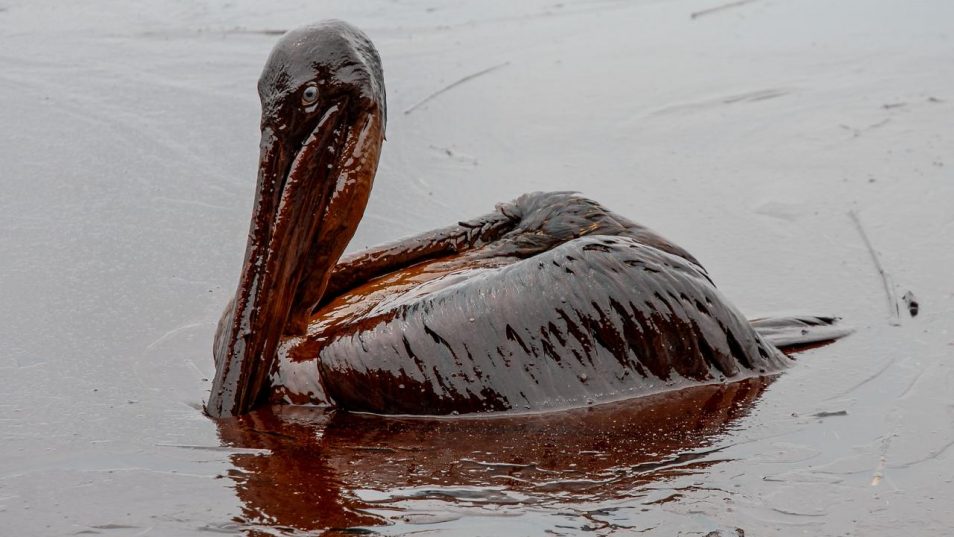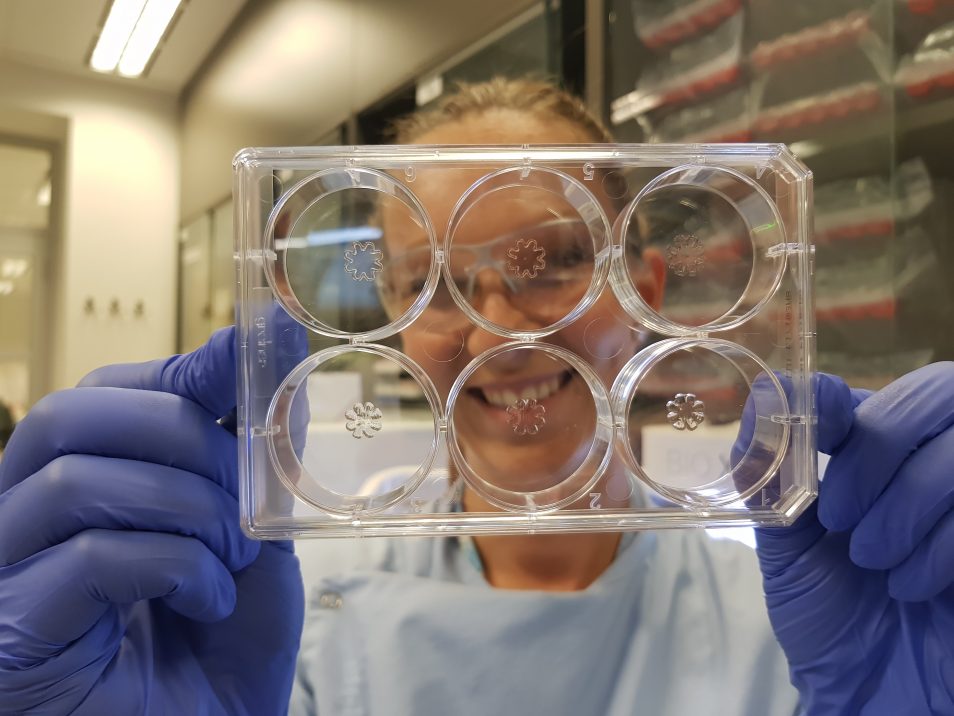
The 2010 Deepwater Horizon oil spill is often cited as the worst environmental disaster in U.S.A’s history.
The Deepwater Horizon oil spill of 2010 was the largest and most destructive toxic marine spill in history. Almost 4.9 billion barrels of oil were discharged into the Gulf of Mexico. The slick wreaked widespread havoc over oceans, beaches, wetlands and estuaries.
The spill covered the habitat of more than 8,300 species of fish, crustaceans, birds and other wildlife. In the months after the spill, the area contained 40 times more polycyclic aromatic hydrocarbons (PAHs) than it did before. PAHs include carcinogens and chemicals dangerous to human and animal life. This was a disaster on a monumental scale.
Remediation efforts were intense but laborious, and in many cases had side-effects on the environment.

Seabird losses from the 2010 Deepwater Horizon oil spill estimated at hundreds of thousands. Photo: Office of Governor Jindal/ Louisiana Gohsep.
Sci-fi or synthetic biology?
Imagine an army of synthetic, jellyfish-like organisms that could be deployed to ‘hunt and kill’ pollutants like PAHs. They could be released in marine environments after toxic spills, breaking down toxins down as they move through the affected area.
They would be immense in number, but non-replicating. Able to absorb the toxic chemicals before they cause any great harm.
While it might seem like a sci-fi fantasy, this solution is actually closer to reality than you would think – thanks to the wonders of synthetic biology.

Dr Nina Pollak holding up printed prototypes of the synthetic jellyfish.
Synthetic biology to the rescue
Synthetic biology is a rapidly growing research area and industry. It brings together principles from biology and engineering together to design and construct new biological entities (such as enzymes, genetic circuits, and cells) or to redesign existing biological systems.
Synthetic biology is used for important applications like bioenergy, sustainable biomaterials, new therapeutics, biosensors, and food production.
We see a great future in synthetic biology, so we set up the Synthetic Biology Future Science Platform (SynBio FSP). One of our most exciting new projects is to create a multicellular structure, a bit like biological tissue, which can move and sense certain things in marine environments.
A (multicellular) tissue for your (toxic spill) issues
We want to create a new multicellular structure to detect toxins in aquatic environment. Once it has detected the toxins, it will mimic natural processes from our body’s detoxification organ, the liver. It will then produce animal liver enzymes that break down the toxins.
The multicellular structures could be used to restore the balance of nature in the wake of pollution incidents.
“It’s a non-invasive, environmentally sustainable solution for toxic spills. They could even be preemptively deployed in areas that are at risk for toxic spills without impacting the environment around them,” says project lead and SynBio FSP future fellow Dr Nina Pollak, who is also a researcher at the University of the Sunshine Coast, where the research is undertaken.
So should we worry about the possibility of a sea of self-replicating pseudo jellyfish going rogue and invading the ocean, nanobot–style?
No, says Nina. “The pseudo jellyfish will be fully biodegradable and not able to reproduce. There may even be the possibility to implement a ‘kill switch’ into them for biocontainment.” In other words, our scientists could create a ‘self-destruct’ mechanism in these toxin-swallowing synthetic jellies.
“We’re still in the proof of concept stage, but we hope that one day this technology could be used on a wide-spread scale,” said Nina.


1st March 2022 at 11:06 am
Hello, Nikita here. I am a student from Canada and I’d like to cover your cool research in a journalistic class project!
I would like to know if the research is still ongoing, and ask a few questions about it.
Cheers!
1st March 2022 at 1:02 pm
Hi Nikita, thanks for your comment. Our team will reach out to you and we will do what we can to help with your project. Keep an eye on your inbox!
Thanks,
Georgia
Team CSIRO
19th November 2019 at 12:04 pm
Hi nicholas,
I student in Semarang 11 Senior High School, Indonesia. My name is Arif Maulana, i want comment on your article.
if the jellyfish die, will the poison that has been absorbed re-spread in the sea? Why does it have to be an artificial jellyfish? do not want to make multicellular besides jellyfish ??
will the detected and solved poison produce new poison? if so, that means you have to make a new breakthrough besides jellyfish. which is more multifunctional and can double all work in the water.
I look forward to meeting you, I want to know more about your interesting ideas and learn more.
19th November 2019 at 11:55 am
Hi nicholas,
Im from Semarang 11 Senior High School, Indonesia. My Name is Arif Maulana. Let me comment in your article.
If the jellyfish die, will the poison that has been absorbed re-spread in the sea? Why does it have to be an artificial jellyfish? do not want to make multicellular besides jellyfish ??
Will the detected and solved poison produce new poison? if so, that means you have to make a new breakthrough besides jellyfish. which is more multifunctional and can double all work in the water.
I look forward to meeting you, I want to know more about your interesting ideas and learn more. Thank you (3/07)
19th November 2019 at 3:40 pm
Hi Arif,
This is Nina, the lead researcher on this project. Thank you for your great question. Instead of trapping the toxin within the artificial jellyfish, I aim to have the pseudo-organisms break down the toxin. This means, even if these synthetic jellyfish dissolve, no toxins are released back into the environment. Please note, artificial jellyfish can’t ‘die’, because thinking about the definition of life ,they are not truly alive due to lack of reproduction capability.
7th November 2019 at 2:26 pm
Hi nicholas,
I’m a student from semarang 11 senior high school, Indonesia. My name is Harris Prawironegoro. Let me comment in your article.
That’s a nice thought, but how long we could do that ?, if it’s really happen, what is the effect for the ocean enviroment?, will it impact for a ocean population ?. How about reduce the oil use with solar power or electric power. I think that is more efficient to reduce oil spill incident, because oil is not important anymore because it have been replacing with solar and electric power. Thank you (3/01)
8th November 2019 at 1:06 pm
Hi Harris,
This is Nina, the lead researcher on this project. Thank you for your interest and hello from Australia!
These are great questions! Let me answer each one.
a. What is the effect for the ocean environment?
We will test the pseudo-jellyfish in the laboratory for any effects on the environment first. Only after a very thorough approval process pseudo-jellyfish may be tested in a small contained system, imagine a lake to make sure no negative effects are observed. The pseudo-jellyfish are designed to dissolve with time, leaving no trace back.
b. Will it impact for a ocean population ?
if pseudo-jellyfish are released directly at the site of pollution, this future technology may be able to contain the spill.
The ocean is big, I believe too diluted spills won’t be reasonable to tackle at the start, but in the far away future it may be possible
Think about other sorts of spills, such as nitrogen-based fertilizer from agriculture. Pseudo-jellyfish could be made to break down all sorts of toxic chemicals.
c. How about reduce the oil use with solar power or electric power. I think that is more efficient to reduce oil spill incident, because oil is not important anymore because it have been replacing with solar and electric power.
I agree, decreasing the probability of future oils spills is the way to go in the first place. However, we still need technology to clean up after a spill in case it happens. Solar power is a great example. It is renewable and less likely to cause toxic spills, but don not forget about toxic waste associated with solar panels.
7th November 2019 at 2:25 pm
Hi nicholas ,
I’m a high school student. My name is Isa. I want comments your topic. In my opinion this problem solving very nice, but there are have effects? And Are going to disrupt the environment around that jellyfish?
Thanks,I’ m sorry.. if what I said before offended you..
3/22
8th November 2019 at 1:08 pm
Hi Isa,
My name is Nina, and I’m the lead researcher on this project. Thank you for your interest and hello from Australia!
a. In my opinion this problem solving very nice, but there are have effects?
Thank you Isa, for letting me know that you like the solution. I imagine, a pseudo-jellyfish could be released in the future, at the site of a spill helping to contain the spill, avoid spreading of the toxic material and reduce the toxin. As with any new technology, I will take time to make it efficient.
b. And Are going to disrupt the environment around that jellyfish?
The pseudo-jellyfish are designed to dissolve with time, leaving no trace back. The material is similar to gelatin used in cooking. We follow strict guidelines and will test if pseudo-jellyfish have any negative effects on the environment, before pseudo-jellyfish will leave contained laboratory settings.
We hope this answers your questions!